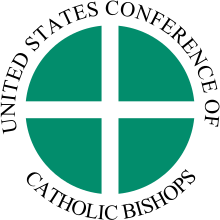Roman Catholic Archdiocese of Louisville
The Roman Catholic Archdiocese of Louisville consists of twenty-four counties in the central American state of Kentucky, covering 8,124 square miles (21,040 km2). It is the seat of the Metropolitan Province of Louisville, which comprises the states of Kentucky and Tennessee. The cathedral church of the archdiocese is the Cathedral of the Assumption.
Archdiocese of Louisville Archidioecesis Ludovicopolitana | |
|---|---|
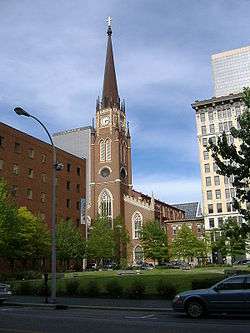 Cathedral of the Assumption | |
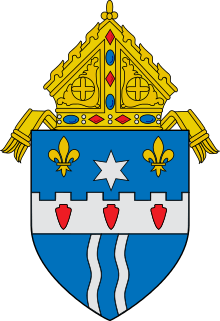 | |
| Location | |
| Country | |
| Territory | Central Kentucky |
| Ecclesiastical province | Louisville |
| Statistics | |
| Population - Total - Catholics | (as of 2018) 1.1 million 218,000 (17.7%) |
| Parishes | 110 |
| Schools | 46 K-12 Schools 3 Colleges/Universities |
| Information | |
| Denomination | Catholic |
| Sui iuris church | Latin Church |
| Rite | Roman Rite |
| Established | April 8, 1808 |
| Cathedral | Cathedral of the Assumption |
| Patron saint | Saint Joseph
|
| Current leadership | |
| Pope | Francis |
| Archbishop | Joseph Edward Kurtz Archbishop of Louisville |
| Map | |
 | |
| Website | |
| archlou.org | |
History
The Diocese began in 1808 when the Roman Catholic Diocese of Bardstown centered in Bardstown, Kentucky, which was then a thriving frontier settlement. It was established along with the dioceses of Boston, New York, and Philadelphia by Pope Pius VII, (1742–1823, served 1800–1823), out of the territory of the Diocese of Baltimore, the first Catholic diocese in the United States, which was first "erected" (established) in 1789 with the first bishop in the US, John Carroll, who was ordained/consecrated in Britain in 1790. Pope Benedict XVI's visit to the U.S. in April 2008 celebrated the 200th anniversary of the creation of these wider dioceses and the elevation of Baltimore to an archdiocese (known as "The Premier See"). When founded, the Bardstown Diocese included most of the new states of Kentucky, Tennessee, Missouri, Illinois, Indiana, Ohio, and Michigan—the western territories of America to the Mississippi River and the Louisiana Purchase of 1803.
While Louisville is the oldest inland diocese in the United States, it is not the oldest west of the Appalachians. That distinction belongs to the Roman Catholic Archdiocese of New Orleans founded under Spanish rule in 1793, and which territory as part of the Louisiana Purchase became a part of the US in 1803, and Louisiana admitted as a state in 1812.
Benedict Joseph Flaget was the first Bishop of Bardstown. The historic Basilica of Saint Joseph Proto-Cathedral, the former cathedral of the Diocese of Bardstown, is now a parish church, and a national historic site.
While the French may have had initial influence in the formation of the Roman Catholic community in the Louisville area, eventually immigrants from Germany comprised the bulk of the Archdiocese's communicant strength later in the mid-19th century, particularly in the city of Louisville. However, much of the Catholic population in areas southeast of Louisville is of English extraction, consisting of descendants of recusants who originally settled in Maryland in colonial times.
In 1841, the diocese was moved from Bardstown to Louisville, becoming the Diocese of Louisville. The Diocese of Louisville was elevated in 1937 to become the Archdiocese of Louisville, and the "metropolitan" (supervising) province for all the dioceses in Kentucky and Tennessee with an Archbishop of Louisville. There are currently three deaneries: Elizabethtown, Lebanon, and Bardstown.
Statistics
As of 2018, the archdiocese contains approximately 200,000 Catholics in 66,000 households, served by one hundred twenty-two parishes and missions. One half of all Catholics in the Commonwealth reside within the bounds of the Archdiocese of Louisville, and seventy-nine percent of all Catholics in the archdiocese (forty percent of all Catholics in the Commonwealth) reside in the Louisville Metro area. There are fifty-nine Catholic elementary and high schools serving more than 23,400 students. The archdiocese is home to one hundred sixty-six diocesan priests, one hundred twelve permanent deacons, fifty-two religious institute priests, seventy-seven religious brothers, and nine hundred forty-four religious sisters. The archdiocese serves more than 220,000 persons in Catholic hospitals, health care centers, homes for the aged, and specialized homes. Services, mother-infant care program, senior social services, and rural ministries services.
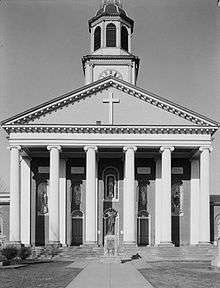
Bishops
The lists of bishops and their years of service:
Bishops of Bardstown
- Benedict Joseph Flaget, S.S. (1808-1832)
- John Baptist Mary David, S.S. (1832-1833)
Bishops of Louisville
- Benedict Joseph Flaget, S.S. (1833-1850)
- Martin John Spalding (1850-1864), appointed Archbishop of Baltimore
- Peter Joseph Lavialle (1865-1867)
- William George McCloskey (1868-1909)
- Denis O'Donaghue (1910-1924)
- John A. Floersh (1924-1937)
Archbishops of Louisville
- John A. Floersh (1937-1967)
- Thomas Joseph McDonough (1967-1981)
- Thomas Cajetan Kelly, O.P (1981-2007)
- Joseph Edward Kurtz (2007–present)
Coadjutor bishops
- John Baptist Mary David, S.S. (1819-1832)
- Guy Ignatius Chabrat, S.S. (1834–1847), did not succeed to see
- Martin John Spalding (1848-1850)
Auxiliary bishop
- Charles Garrett Maloney (1954-1988)
Other priests of this diocese who became Bishops
- John McGill, appointed Bishop of Richmond in 1850
- John Lancaster Spalding, appointed Bishop of Peoria in 1876
- Michael Heiss, appointed Bishop of La Crosse in 1868 and later Archbishop of Milwaukee
- James Ryan, appointed Bishop of Alton in 1888
- Theodore Henry Reverman, appointed Bishop of Superior in 1926
- Francis Ridgley Cotton, appointed Bishop of Owensboro in 1937
- James Kendrick Williams, appointed auxiliary bishop of Covington in 1984 and later Bishop of Lexington
- William Francis Medley, appointed Bishop of Owensboro in 2009
- Charles Coleman Thompson, appointed Bishop of Evansville in 2011 and later Archbishop of Indianapolis
- J. Mark Spalding, appointed Bishop of Nashville in 2018
Education
High schools
Ten Catholic secondary schools serve more than 6,300 students. Eight of the schools are located in Jefferson County and one in Nelson County. Four of the schools enroll only girls, three enroll only boys, and two are coeducational.[1]
Boys
- St. Francis DeSales High School, Louisville
- St. Xavier High School, Louisville
- Trinity High School, St. Matthews
Girls
- Assumption High School, Louisville
- Mercy Academy, Louisville
- Presentation Academy, Louisville
- Sacred Heart Academy, Louisville
Coeducational
- Bethlehem High School, Bardstown
- Holy Cross High School, Louisville
Other
- Pitt Academy, Louisville (special needs school)
Elementary schools
Forty Catholic parish, regional, and special elementary schools serve more than 15,500 students in seven counties of the Archdiocese of Louisville.[2]
- Saint Mary Academy, began in 2007 as a merger of Mother of Good Counsel Elementary School and Immaculate Conception School[3]
- St. Andrew Academy was established in 2005 following the regionalization of three parish schools in Southwest Jefferson County. The three parish schools that united to combine St. Andrew were Our Lady of Consolation, St. Clement and St. Polycarp. In April 2008, the parishes of St. Clement, Our Lady Help of Christians, Our Lady of Consolation, St. Polycarp and St. Timothy combined to form St. Peter the Apostle. St. Andrew Academy is now the parish school of St. Peter the Apostle.[4]
- Notre Dame Academy is a regional K8 school located in Louisville, Kentucky. The school was formed in 2004 from the merger of St. Denis, St. Helen, and St. Lawrence Schools.
Metropolitan Province of Louisville
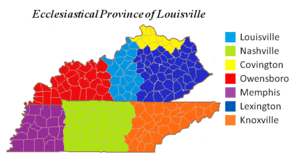
The Metropolitan Province of Louisville covers the states of Kentucky and Tennessee, and comprises the following dioceses:
- Archdiocese of Louisville
- Diocese of Covington
- Diocese of Knoxville
- Diocese of Lexington
- Diocese of Memphis
- Diocese of Nashville
- Diocese of Owensboro
Legal Controversy
Sex abuse scandals
In 2003, the Archdiocese of Louisville paid $25.7 million directly from its own assets to settle claims of sexual abuse by its clergy. Reports of abuse extended back to the 1940s, were alleged to have continued to 1997, and involved 34 priests, two religious brothers, and three lay people.[5] In 2009, the Diocese of Covington paid 243 victims an average of $254,000 after they were victimized by 35 priests.[6] The total settlement, $79 million, was the sixth largest in the US (as of 2017).[6]
Joseph Hemmerle and Camp Tall Trees
In 2019, Father Joseph Hemmerle, who was convicted in 2016 for molesting a ten-year-old boy while serving at the Camp Tall Trees summer camp in 1973,[7][8] lost a bid for appeal.[8] Hemmerle, who was also denied parole in 2017,[9] is serving a seven-year prison sentence for this crime,[10] which was recommended following his conviction.[8][7] In 2017, he received an additional two years after pleading guilty to molesting another boy at Camp Tall Trees in 1977 and 1978.[11]
Notable figures in the history of the archdiocese
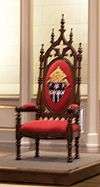
- Thomas Merton (January 31, 1915 – December 10, 1968) – American Trappist monk and author, famed for his work in Buddhist-Christian relations. Entered the Abbey of Gethsemani in the Archdiocese of Louisville in 1941.
- Bishop Benedict Joseph Flaget (1763–1850) was the first and only Bishop of Bardstown and the first Bishop of Louisville. Invariably called "the saintly Flaget", Bishop Flaget served as bishop from 1810 until his death in 1850.
- Father Stephen T. Badin (1768–1853) – The "circuit rider priest". Served the area that would become the Diocese of Bardstown (and later the Archdiocese of Louisville.) The first priest to be ordained in the United States, Father Badin was known as overly strict but zealous.
- Father John L. Spalding (1840–1916) helped found Catholic University in Washington, D.C., and was called the "Catholic Emerson" because of his many books of essays. Father Spalding later became the Bishop of Peoria, Illinois.
- Father James C. Maloney (1911–1998) – founded Boys' Haven in Louisville in 1948. His brother is Bishop Charles Maloney.
- Monsignor Alfred F. Horrigan (1914–2005) was the founding president of Bellarmine College, now Bellarmine University. He also headed the city's Human Relations commission and was a friend of Thomas Merton.
Coat of arms
 |
One fleur-de-lis represents Louisville's being named in honor of Louis XVI of France; the other represents the early French missionaries who brought the Catholic faith to the region, including pioneering Bishop Joseph Benedict Flaget. The white star represents Our Lady of the Assumption, patroness of the cathedral. |
See also
- Catholic Church by country
- Catholic Church hierarchy
- List of the Catholic dioceses of the United States
- Religion in Louisville, Kentucky
Notes
- "Archdiocese of Louisville: High Schools". Archdiocese of Louisville. Archived from the original on 2008-06-04.
- "Archdiocese of Louisville: Elementary Schools". Archdiocese of Louisville. Archived from the original on 2007-11-03.
- "Saint Mary Academy: Home - Louisville, KY". Saint Mary Academy.
- "Saint Andrew Academy".
- "Archdiocese of Louisville Reaches Abuse Settlement". The New York Times. June 11, 2003. Retrieved March 2, 2018.
- Rowe, Peter. "Largest sexual abuse settlements by Roman Catholic institutions in the U.S." sandiegouniontribune.com.
- https://ktxs.com/news/texas/the-latest-priest-convicted-in-70s-summer-camp-case_
- https://www.wave3.com/2019/01/11/louisville-priest-convicted-inappropriately-touching-child-denied-appeal/
- https://www.courier-journal.com/story/news/2017/12/21/louisville-priest-convicted-sexual-abuse-70-s-has-been-denied-parole-board/974605001/
- https://www.wlky.com/article/priest-sentenced-for-abusing-boy-in-1970s/8696822
- https://www.wdrb.com/news/kentucky-priest-to-be-sentenced-on-child-molestation-charges/article_38bf6b75-232d-5b35-88bb-d6feed99ca9a.html
